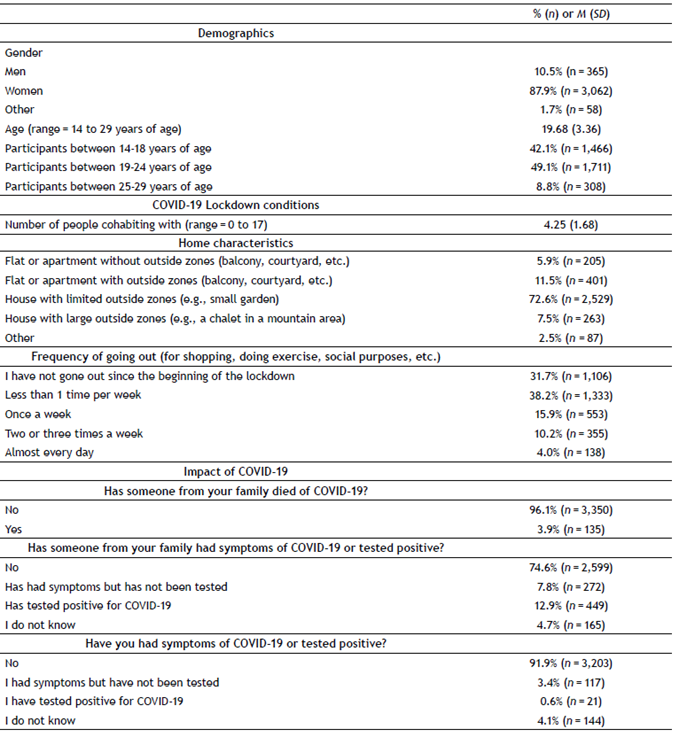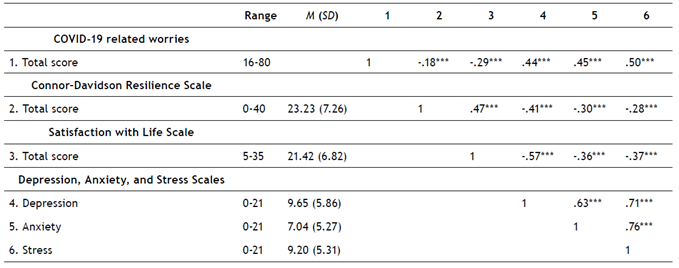The coronavirus (COVID-19) pandemic has dramatically disrupted daily life, forcing societies to face an unprecedented global challenge. During the first phases of the pandemic, the very lack of effective treatments against severe manifestations of the disease and a vaccine to prevent contagions and mitigate its transmission led to reliance on physical distance measures as the most effective way to control the pandemic (Chu et al., 2020). In order to strengthen the efficacy of this approach, governments by way of public health measures, encouraged individuals to avoid social contact. In many countries, these measures were articulated in complete lockdown scenarios: the strictness, duration, and conditions of these lockdowns greatly varied between countries (Hale et al., 2021), but typically involved mandatory home confinement and complete restriction of public activities.
Psychological impact of the COVID-19 pandemic
Evidence suggests that the COVID-19 pandemic is associated with an increased risk of developing affective disorders, psychological distress, and poor mental wellbeing (Wu et al., 2021), as well as with an exacerbation of pre-existing mental health conditions (Campion et al., 2020). Children and adolescents are not oblivious to this reality, and aspects such as school closures or isolation from peers (Viner et al., 2022) explain the notable increase in the prevalence of mental health problems in these developmental stages (Newlove-Delgado et al., 2021). Throughout the pandemic, children, adolescents, and adults have experienced increased negative emotions, problems with sleep regulation, somatic symptoms, unhealthy lifestyle patterns, and/or an increased prevalence of anxiety disorders and depression (Brooks et al., 2020; Ma et al., 2021). These symptoms appeared as an early psychological response during the first phases of the outbreak, when individuals were challenged by the uncertainty concerning the course of the pandemic and the impact of mandatory lockdowns (Xiong et al., 2020). Despite the subsequent relaxation of measures for controlling the pandemic, some individuals still struggle to cope with these acute psychological responses, while a large proportion of the population copes with the so-called ‘pandemic fatigue’ (i.e., a mild reaction of demotivationand distress due to the sustained adversity in people’s lives derived from the COVID pandemic) (Reicher & Drury, 2021).
The fear of contagion and its consequences, together with the profound political, social, and economical impact of the pandemic, constitute a few of the most common worries reported by a large proportion of the global population (Schimmenti et al., 2020). Children and adolescents experience similar worries (Masuyama et al., 2022), sometimes exacerbated by the fact that parents’ and educators’ attempts to remove them from the pandemic may foster irrational or exaggerated fears (Smirni et al., 2020). While some levels of fear may be positive in promoting adherence to health measures (Harper et al., 2020), extreme fear may lead to detachment from COVID-19 restrictions and to psychopathology (Rossi et al., 2020). In a recent metanalysis, Şimşir et al. (2021) found that the level at which people experience fears and worries related to the COVID-19 pandemic was a strong predictor of anxiety, stress, and depression. One of the central conclusions of this metanalysis was that an individuals’ level of COVID-19 related worries and fears constitutes one of the best predictors of the onset of mental health problems in the context of the pandemic. Therefore, fear and worries may play a central role when it comes to explaining initiation, escalation/progression, maintenance, and the clinical course of psychological problems brought about by the COVID-19 pandemic.
Recently, several studies have underscored the relevance of certain psychological traits when it comes to arbitrating the relationship between COVID-19 fears and worries and the onset of psychopathological reactions (Rossi et al., 2020). These studies suggest that certain psychological traits may act as mediators in explaining the negative impact of COVID-related fears and worries. In a cross-sectional study carried out with healthcare professionals treating patients with COVID-19, Yıldırım et al., (2020) found that resilience mediated the negative impact of COVID-19 fears with respect to depression, anxiety, and stress. Besides this moderating role, resilience has a direct impact on mental health. In particular, resilience was related to a reduction in anxiety and depression (Barzilay et al., 2020), which was consistent in both males and females, implying that gender did not influence the relationship between resilience and psychopathology. Resilience, defined as “the capacity of individuals facing traumatic situations to maintain a healthy level of physical and psychological functioning, as well as the ability to generate positive experiences and emotions” (Bonanno et al., 2008), may promote post-traumatic growth by helping individuals to cope with unpleasant situations related to the pandemic. Together with resilience, other protective factors have demonstrated their relevance when mediating the negative impact of COVID worries. This is the case of life satisfaction, a construct broadly defined as “a global evaluation of the quality of one’s life as a whole” (Pavot & Diener, 2008). Recent studies indicate that life satisfaction as well as resilience levels significantly decreased during the pandemic (Zacher & Rudolph, 2021) and another study confirmed that COVID-19 related worries and fears have a direct impact on reducing life satisfaction (Satici et al., 2020). Finally, Trzebiński et al. (2020) found a negative association between COVID-19 related fears and life satisfaction; in turn, life satisfaction was negatively associated with anxiety in the pandemic context.
The present study
The reviewed studies support the hypothesis that certain individual traits may play a central role when it comes to mediating the negative impact of COVID-related fears and worries regarding mental health. However, much more research is needed in order to clarify the exact role and the extent to which these factors mediate the onset of psychological problems in the pandemic context. The aim of this study was to test the accuracy of a predictive model in which resilience and life satisfaction mediate the relationship between COVID-19 related worries and the development of symptoms of depression, anxiety, and stress (Figure 1). According to the proposed model, we expect to find: (1) a direct positive effect of COVID-19 related worries on symptoms of depression, anxiety, and stress; (2) that both resilience and life satisfaction would be negatively affected by COVID-19 related worries; (3) a direct negative effect of resilience and life satisfaction on depression, anxiety, and stress; and (4) an indirect effect of COVID-19 related worries on current psychopathological symptomatology mediated through resilience and life satisfaction.
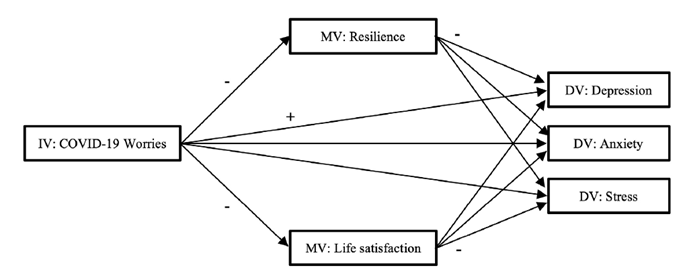
Note: IV = independent Variable; MV = mediator Variable; DV = dependent variable
Figure 1 Graphic depiction of the mediational model tested in this study.
A secondary aim of this research was to test whether the proposed mediation model (Figure 1) was equally applicable to both males and females and across different age groups. The extent to which the COVID-19 pandemic is impacting on individuals’ mental health depends on multiple aspects, and certain individuals may be more vulnerable to its psychosocial effects. Age and gender may play a relevant role when explaining increased psychopathology in the pandemic context but we do not expect these variables to affect the way in which resilience and life satisfaction mediate between COVID-19 related worries and fears and psychopathology (Xiong et al., 2020). In other words, gender and age may affect the ‘levels’ of mental health symptoms during the COVID-19 pandemic, but not the ‘pathways’ explaining their onset and severity (Barzilay et al., 2020). Thus, we hypothesised that our mediation model would be invariant according to these variables.
Method
Sample and procedure
This study was carried out between May 22nd and June 3rd, 2020, in Chile. By May 22nd, 2020, Chile was one of the most affected countries in terms of confirmed COVID-19 cases and deaths in Latin America (70445 and 630 respectively) (Dong et al., 2020). According to the Oxford COVID-19 Government Response Tracker, the lockdown stringency index in Chile during data collection was 78.24 (Hale et al., 2021), meaning that during the time the study was conducted, Chile was under a strict lockdown. During this lockdown, the government ordered closures of schools and universities, non-essential shops and leisure centres, limitation of mobility, promotion of home office, among other measures.
The present research was approved by the Ethics Commission of the University of Valencia (Ref.num.:1595575567385, date: 25/07/2020) and the data were collected following the standards of the Declaration of Helsinki. The research was carried out by means of an online secured platform (i.e., limesurvey (LimeSurvey GmbH, Hamburg, Germany)), which was distributed by means of banners posted on social networks (Facebook, Twitter, Instagram, etc.). Data collection was conducted following a snowball sampling method, where participants could share the link to the online survey with their online contacts. Before accessing the survey, participants were informed with regard to the purpose of the study and the anonymity of their responses and gave their informed consent to participate. Participants aged 16 and older signed the informed consent by themselves. In the case of adolescents under 16 years of age, their parents or legal guardians signed the consent. The average time for completion the study was 22.50 minutes (SD = 18.85) and participants did not receive any compensation for their participation.
During the time the study was available, a total of 4135 participants accessed the survey. Participants were eligible if: (a) they were between 14-30 years of age and (b) spent the lockdown in Chile. Initial data derived from the onlineplatform were screened to avoid duplicitous, inconsistent, and/or unreliable responses (e.g., participants reporting >100 years of age, providing contradictory responses, etc.). In order to identify and delete participants who randomly answered the study measures, we administered the Oviedo Infrequency Scale (INF-OV (Fonseca-Pedrero et al., 2010)). Participants incorrectly responding to more than 25% of the items were removed from the study. Furthermore, only those participants who completed 100% of the survey were included (i.e., we did not handle missing data in our dataset). The final sample consisted of 3485 participants between 14-29 years of age (M = 19.68; SD = 3.36). Table 1 shows the participants’ characteristics.
Participant characteristics
Participants were asked about basic demographic information (gender and age), the conditions in which the lockdown took place (number of people living together, housing characteristics, and frequency of leaving the house), and the personal/familiar impact of COVID-19 (whether participants or their family have been infected with COVID-19).
Identification of random, pseudorandom, or dishonest responses
In order to identify random, pseudorandom, or dishonest responses, we administered the 12-item Oviedo Infrequency Scale (INF-OV (Fonseca-Pedrero et al., 2010)). This scale enquires regarding extremely common situations (e.g., “I have sometimes been alone at home”, “I have sometimes seen children playing in the park”, or “I know people who wear glasses”) or extremely basic knowledge (e.g., “You get from Madrid to Moscow quicker by car than by plane”), where negative responses are indicative of random or dishonest responses.
Worries about COVID-19 and its consequences
The Worries about COVID-19 and its Consequences Scale (W-COV) was originally developed for the assessment of COVID-19 related worries and fears in Spain, but subsequent studies in other Hispanic countries (Mexico, Colombia, and Chile) have demonstrated its cross-cultural validity (Mónaco et al., 2022). The W-COV comprises 16 items answered on a 5-point Likert scale. This scale assesses three aspects: (a) concerns regarding one’s own and others’ health status (e. g. “I worry about getting sick or dying from COVID-19”), (b) preoccupations related to domestic economy (e. g. “I am worried that COVID-19 will harm my or my family’s economic situation”), and (c) concerns with respect to social relationships and psychological health (e. g. “I am worried about my psychological state -anxiety, insomnia, irritability, sadness-”). As for its factorial structure, authors of the W-COV proposed a bifactorial solution for the scale (Mónaco et al., 2022). The adjustment of this solution in our sample was excellent (RMSEA = .057; SRMR = .039; CFI = .923; GFI = .923), meaning that the W-COV was suitable for use in the assessment of three particular COVID-related worries (health, economic, and psychosocial preoccupations) and also as a general index of COVID-related worries (total score) in our study. In our research, reliability of the W-COV total score (α = .86; ω = .86) and subscales of health (α = .78; ω = .78), economic (α = .74; ω = .73), and psychosocial preoccupations (α = .79; ω = .80) was appropriate as well.
Resilience
The abbreviated version of the Connor-Davidson Resilience Scale (CD-RISC) consisted of 10 items measuring general resilience (Campbell-Sills & Stein, 2007). Examples of items comprising this scale are: “Able to adapt to change”, “Not easily discouraged by failure”, or “Can deal with whatever comes”. Items are scored on a 5-point Likert scale, with a total score ranging between 0-40 (higher scores indicate a higher level of resilience). The Spanish version of the 10-item CD-RISC confirmed this one-factor solution and obtained an appropriate reliability in a sample of university students (α = .85) (Notario-Pacheco et al., 2011). In our study, the reliability of the CD-RISC was appropriate (α = .88; ω = .85).
Life satisfaction
The Satisfaction With Life Scale (SWLS) is a 5-item unidimensional measure of life satisfaction (Diener et al., 1985). Specifically, the SWLS measures the cognitive component of life satisfaction (i.e., the persons’ appraisal of the extent to which they are satisfied with their life overall), rather than focusing on affect. An example item is: “In most ways my life is close to my ideal”. Items are scored on a 7-point Likert scale and are added up to a life satisfaction overall score ranging from 5 (low satisfaction) to 35 (high satisfaction). The internal consistency of the Spanish version of the SWLS was .84 in young people (Atienza et al., 2000). In our study, Cronbach’s alpha and McDonald’s omega values were .90 and .90 respectively.
Symptoms of depression, anxiety, and stress
The Depression, Anxiety, and Stress Scales (DASS-21) is a widely used screening tool to assess symptoms of emotional distress (Lovibond & Lovibond, 1995). The DASS-21 comprises 21 items, 7 items for each of the three subscales (depression (e.g., “I couldn’t seem to experience any positive feeling at all” or “I felt that life was meaningless”), anxiety (e.g., “I was aware of dryness of my mouth” or “I felt scared without any good reason”), and stress (e.g., “I tended to over-react to situations” or “I found it difficult to relax”)), which are rated on a 4-point Likert scale, resulting in a total score ranging from 0 (absence of symptoms) to 21 (severe symptomatology). The Spanish version of the DASS reported an appropriate reliability when applied in a sample of 365 Spanish university students (αdepression = .84; αanxiety = .70; αstress = .82) (Bados et al., 2005). In our study, the reliability of the depression (α = .93; ω = .88), anxiety (α = .87; ω = .88), and stress (α = .90; ω = .89) subscales was excellent.
Data analysis
Descriptive analyses (i.e., means and percentages) were first conducted to characterise participants in terms of basic sociodemographic information, COVID-19 lockdown conditions, and the impact of COVID-19. Afterward, descriptive analyses and Pearson correlations were performedbetween all observed variables. Finally, we used Structural Equation Modelling (SEM) analyses to test the mediation model proposed in Figure 1. We approached this analysis using SEM because of its superiority over alternative methods (e.g., ordinary least square regressions (OLS)) (Bryan et al., 2007). The software used to perform this analysis was EQS 6.4. Non-normal distribution of the study measures was addressed by applying robust estimation methods. Goodness of fit for the SEM model was assessed by means of the following indices: the relative chi-square (χ2/df), the root mean square error of approximation (RMSEA), the comparative and incremental fit indices (CFI and IFI, respectively), and the standardised root mean square residual (SRMR). The model fit was considered acceptable when the χ2/df was < 3, the CFI and the IFI were ≥.90, the RMSEA ≤.08, and the SRMR ≤.10 (Hooper et al., 2008). For the sake of transparency, Satorra-Bentler chi-square (χ2) and general model significance (p) were reported; however, given that χ2 is highly sensitive to sample size (Markland, 2007), which in our study exceeds the standards required for conducting these types of analysis (Hair et al., 2010), these indices were not employed to assess the adequacy of the SEM model.
In order to test the indirect effects, we used an EQS function that implements Sobel’s test of significance of indirect effects (Sobel, 1987). To assess whether the mediation model was valid for use in both males and females and across ages, multi-group SEMs were conducted. Specifically, we tested four levels of measurement invariance: (a) configural (i.e., testing whether the model -i.e., the relation between the study variables- was consistent across ages and genders), (b) metric (i.e., testing whether loadings between model variables -i.e., the strength of the associations- were consistent across ages and genders), (c) scalar (i.e., testing whether intercepts were equal across ages and genders), and (d) error variance invariance (i.e., testing whether measurement errors were equal across ages and genders). For gender invariance, multigroup SEM was performed comparing two groups (i.e., males and females); for age invariance, multigroup SEM was performed comparing three groups (i.e., adolescents between 14-18, young adults between 19- 24, and adults between 25-29 years of age). The adequacy of the increasingly constrained models was assessed by way of the difference between pairs of nested models (△) in the RMSEA, CFI and SRMR. A change ≥ .01 in the CFI, ≥ .015 in the RMSEA, and ≥ .03 in the SRMR indicates a significant decrease in the model fit when testing for measurement invariance (Chen, 2007).
Results
Correlations between study measures
As shown on Table 2, the total score in the COVID-19 related worries scale was negatively correlated with resilience and life satisfaction, and positively correlated with depression, anxiety, and stress. On the contrary, both resilience and life satisfaction negatively correlated with depression, anxiety, and stress. Finally, correlations between resilience and life satisfaction were positive and significant. Range and mean scores for each scale are also depicted on Table 2.
Structural Equation Modelling (SEM) and multigroup SEM
The potential mediation effect of resilience and life satisfaction on the relationship between COVID-19 related worries and depression, anxiety, and stress (Figure 1) was tested using SEM. Goodness-of-fit indices for the tested model are reported on Table 3: the RMSEA (.058), and SRMR (.086) indicated that the model presented an appropriate adjustment, but the CFI (.808) and IFI (.808) were below the threshold of .90 which considers the model’s fit as satisfactory. Kenny and McCoach (2003) argued that the CFI and the IFI tend to deteriorate in models comprising a large number of variables and indicators, especially for correctly specified models (note that our model comprised 1,263 df -i.e., a large number of indicators and latent variables-). These authors suggested that models involving low CFI and IFI values give no real cause for concern insofar as the RMSEA presents an appropriate adjustment.
Table 3 Goodness-of-fit indices for the SEM
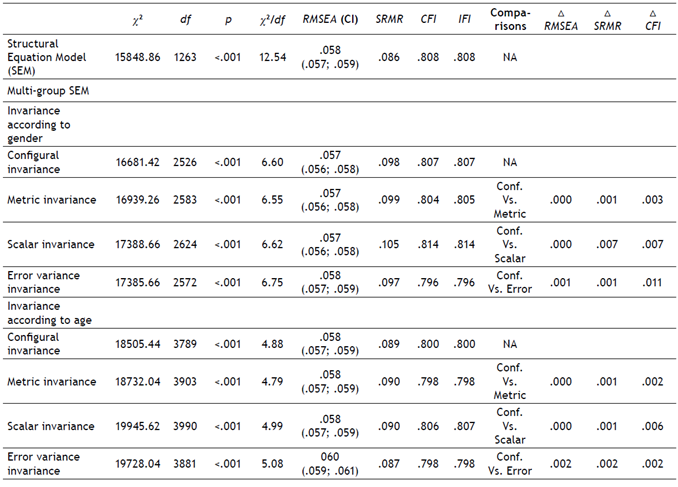
Note. SEM = Structural Equation Model; c2 = Satorra-Bentler chi-square; df = degrees of freedom; p = general model significance; c2/df = normed chi-square; RMSEA = root mean square error of approximation; CFI = comparative fit index; IFI = incremental fit index.
For this reason, we analysed the goodness of fit of our SEM model by relying on the RMSEA and SRMR (both indicating an acceptable adjustment of the tested model).
Standardised parameter estimates are presented in Figure 2. COVID-19 related worries had a direct negative effect on resilience and life satisfaction, explaining 6.2% and 15.4% of their variance. On the contrary, COVID-19 related worries had a direct positive effect on depression, anxiety, and stress. In turn, resilience and life satisfaction had direct negative effects on depression, anxiety, and stress. In order to test the indirect effect of COVID-19 related worries with respect to resilience and life satisfaction, we used an EQS function that implements Sobel’s (Sobel, 1987) test of significance of indirect effects. The indirect effects of COVID-19 related worries on depression (parameter estimate = .380; standard error = .025; Sobel test = 15.20), anxiety (parameter estimate = .083; standard error = .009; Sobel test = 9.14), and stress (parameter estimate = .139; standard error = .015; Sobel test = 9.456) were significant at p < .05, meaning that high levels of resilience and life satisfaction moderates the negative impact of COVID-19 on these psychopathological symptoms. Altogether, direct and indirect effects predicted a large proportion of the variance of depression (60.3%), anxiety (53.7%), and stress (58.9%).
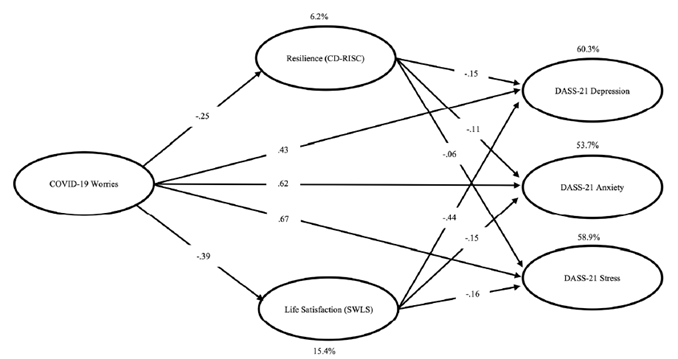
Note: R2 is expressed as a percentage outside the main endogenous variables. Coefficients are reported in standardized format. All parameters are significant. Items comprising each latent variable, as well as error terms, are not included in the figure to facilitate its interpretation.
Figure 2 Structural equation model depicting the direct effect of COVID-19 worries on depression, anxiety, and stress (DASS-21), and the indirect effect mediated through resilience (CD-RISC) and life satisfaction (SWLS).
To test whether this SEM mediational model was equally applicable to both males and females and across ages, multigroup SEMs according to gender and age were conducted. As displayed on Table 3, goodness-of-fit indices supported both gender (RMSEA = .057; SRMR = .098) and age (RMSEA = .058; SRMR = .089) configural invariance. Therefore, we computed models with increasing levels of constraints to test higher levels of invariance. Regarding metric invariance, changes in the RMSEA, SRMR, and CFI did not show a significant worsening in the model fit neither for gender (△RMSEA < .001; △SRMR = .001; △CFI = .003) nor for age invariance (△RMSEA < .001; △SRMR = .001; △CFI = .002). Similarly, the models’ fit did not significantly decrease when scalar and error variance invariance were tested (△ in RMSEA, SRMR, and CFI were always below .015, .03, and .010 respectively), thus supporting a complete equivalence of the model in both males and females and in adolescents between 14-18, young adults between 19-24, and adults between 25-29 years of age.
Discussion
The present study is one of the first to examine the mediating role of resilience and life satisfaction on depression, anxiety and stress symptoms confronting pandemic-related worries, which may provide mental health professionals, such as psychiatrists, practitioners, and nurses useful guidance in protecting the mental health of adolescents and young adults. The aim of this study was to examine the relationship between COVID-19 related worries and symptoms of depression, anxiety, and stress and the extent to which this association was mediated by resilience and life satisfaction, considering potential gender and age differences.
The results stemming from the structural equation model (SEM) confirmed the first hypothesis, indicating that adolescents and young adults who were more concerned about the pandemic and its consequences presented more symptoms of depression and, to a greater extent, more symptoms of anxiety and stress. This result is in line with previous studies reporting that COVID-19-related worries and fears are strong predictors of the development of mental health problems during the pandemic (Şimşir et al., 2021). These findings suggest that fear and preoccupation may be critical to understanding the clinical course of psychological problems caused by the COVID-19 pandemic and lockdown.
The results also support the hypothesis that both resilience and life satisfaction were negatively affected by COVID-19 related worries. Thus, significant direct effects in the SEM model indicated that participants of this study who report more COVID-19 related worries, presented lower levels of resilience and even lower levels of life satisfaction. Our findings confirm the results from recent studies, showing that COVID-19 related worries and fears have a direct impact on reducing resilience and life satisfaction (Satici et al., 2020; Yıldırım et al., 2020). These findings strongly suggest that relatively stable psychological resources used by many people in times of adversity are to some extent susceptible to changes in the environment when facing temporary but persistent challenges associated with the COVID-19 pandemic, hence their well-being may be negatively affected (Zacher & Rudolph, 2021).
Third, we expected to find a direct and negative effect of resilience and life satisfaction on symptoms of depression, anxiety, and stress. The results obtained by our SEM also confirmed this hypothesis, indicating that individuals with higher levels of resilience and life satisfaction reported fewer psychopathological symptoms. Evidently, previous research has identified both variables as strong predictors of individuals’ positive adaptation to the global pandemic (Barzilay et al., 2020; Masten & Motti-Stefanidi, 2020; Trzebiński et al., 2020).
Furthermore, we expected to find an indirect effect of COVID-19 related worries on current psychopathological symptomatology mediated through resilience and life satisfaction, which has been confirmed. Our results show a partial mediation for all three emotional symptoms, indicating that individuals who reported higher levels of COVID-19 related worries show fewer symptoms of depression, anxiety, and stress, which can be in part explained by the fact that they perceive themselves as less resilient and less satisfied with their lives. However, those participants who are less worried about the pandemic and its consequences present lower levels of emotional symptoms, which may be partly explained by their self-perception of resilience and life satisfaction. Our findings are consistent with recent studies, showing the mediating role of resilience and life satisfaction confronting the negative impact of psychological stressors casued by COVID-19 on mental health symptoms, including depression, anxiety and stress (Trzebiński et al., 2020; Yıldırım et al., 2020). Specific interventions aimed at enhancing children’s and adolescents’ resilience and life satisfaction would be useful as both are considered health-promoting resources that enhance positive mental health (Barzilay et al., 2020; Yıldırım et al., 2020).
Finally, our secondary research aim entailed analysing the impact of gender and age on the proposed association between COVID-19 related worries, resilience, life satisfaction and symptoms of depression, anxiety and stress. The results obtained by way of multigroup SEMs confirmed the hypothesis that our mediational model was metricallyinvariant with respect to gender and age. Thus, the strength of the mediating effect of resilience and life satisfaction on the association between COVID-19 related worries and emotional symptoms was equal in both males and females and in the three age categories explored, which is consistent with previous research (Barzilay et al., 2020).
This study makes an important contribution to the current COVID-19 literature as presented below. The study presented data from a large convenience sample during the initial phase of the COVID-19 pandemic, when Chile was under a strict lockdown. One of our main findings was that worries concerning the coronavirus contribute to increased depression, anxiety, and stress symptoms among adolescents and young adults, which may have temporal or long-term psychological consequences threatening their future well-being. An additional finding was related to the mediational role of both resilience and life satisfaction with respect to worries about COVID-19 and mental health symptoms. Although mediational models do not test causality directly, they are very insightful in providing empirical evidence on the potential protective factors that might mitigate the psychological impact of the pandemic, which can guide and help to adapt therapeutic interventions and prevention programmes. Furthermore, our findings expand on the dearth of research regarding psychological factors that may promote the mental health of adolescents and young adults during the current pandemic, while most of the previous research had predominantly studied the impact of the COVID-19 pandemic on the general population.
Limitations and conclusions
Several study limitations should be acknowledged. On the one hand, data collection by means of online survey implies an inherent limitation regarding the conceptualisation of our findings to the general population. However, in this study participants received no payment or economic reward so as to minimise careless responding, and thus the main motivation for completing the survey was to share their opinion. On the other hand, although the use of self-report measures was appropriate for the studied sample given that participants of legal age are reliable informants of their own internal states, future research, however, may use mixed methods (qualitative and quantitative data), or include objective measures to minimise the common method bias. Additionally, the sampling method used in this study was not probabilistic, which might partly explain the disproportionate distribution of gender (88% of the sample were women) and age (< 9% were between 25- 29 years old). Therefore, the results of our study should be interpreted considering that the sample consisted of mostly women between 14-24 years of age. Finally, a cross-sectional design was used, which does not allow establishing causal relationships between the variables studied. Therefore, further research based on longitudinal data is warranted in order to determine the trajectories of mental health conditions during the ongoing COVID-19 pandemic.
In conclusion, our findings indicated that worries concerning the coronavirus contributed to increased depression, anxiety, and stress symptoms among adolescents and young adults, which may have temporal or long-term psychological consequences. However, both resilience and life satisfaction appear to play a mediating role, partly explaining the negative impact of pandemic related worries on mental health. These findings transcend the context of the current pandemic, revealing how young people’s worries regarding extraordinary circumstances such as health or economic crises, political conflict or natural disaster may negatively affect their mental state. In these exceptional situations, developing and increasing their resilience and life satisfaction are essential resources in promoting mental health and well-being among adolescents and young adults1














